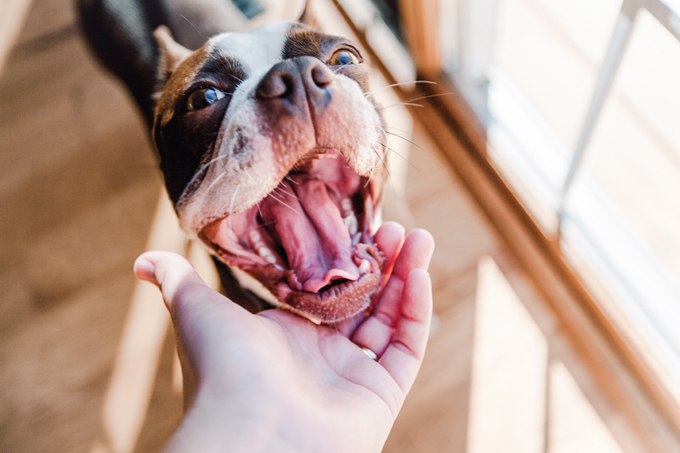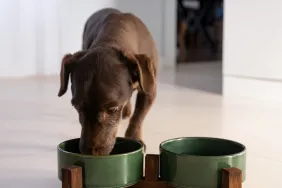February is Pet Dental Health month, and what better way to celebrate than by helping your dog or cat get shiny teeth and healthy gums, without paying big bucks to get their teeth professionally cleaned? That’s right: there’s an easy way to improve your pet’s oral health that is safe, natural, and effective—raw meaty bones.
Now, I know what you’re thinking: “Aren’t bones dangerous?” Lots of people think that (heck, I used to think that too!), but the truth is raw bones aren’t dangerous, especially when you follow a few easy tips (which I’ll share with you in a bit). Before we get to that, though, let’s take a closer look at bones and why they’re one of the best ways to keep your pet’s teeth and gums healthy.
Raw meaty bones (by that, I mean raw bones that still have meat on them) contain a lot of different nutrients, but they are primarily comprised of calcium and phosphorous. Calcium in particular is essential for strong teeth and bones, not to mention muscle contraction (for example, the pumping of the heart), blood clotting, nerve impulse transmission, and more.
But, it’s not just the fact that bones contain calcium and other vital nutrients that make them so important for helping maintain your pet’s pearly whites. Whole raw bones are incredible at supporting good oral health. When you feed raw meaty bones, your pet has to tear, rip, and crunch through raw bone, meat, and tendons. These actions help keep your pet’s mouth healthy and clean. The resistance your pet encounters from the bones, meat, and tendons works to increase the number and tone (and even the distribution) of the capillaries in the gums. This in turn improves the metabolism and health of the structures that surround and support the capillaries. Plus, when your pet chews on raw bones or works to eat raw meaty bones, the bones (along with the meat and tendons) scrape their teeth and gums, much like a toothbrush and floss do for us. This helps keep the teeth clean (and can help get them clean if your pet has a lot of tartar and plaque), and it also helps prevent food build-up, gingivitis, and even periodontal disease. All in all, feeding a raw diet that includes raw meaty bones is the most effective way to ensure your pet doesn’t get dental disease, and it can even reverse some existing damage.
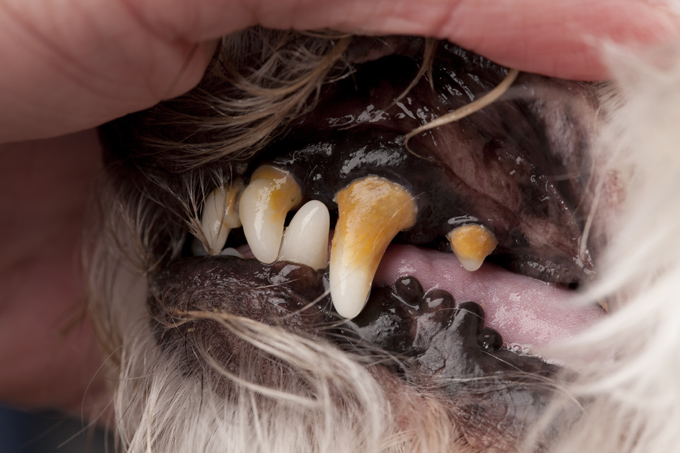
This is vitally important: among cats, dental disease is at near-epidemic levels. I’ve seen estimates that more than 85% over the age of 3 have periodontal diseases. And by the age of 2, an estimated 80% of dogs have periodontal disease. And periodontal disease can have far-reaching consequences for both cats and dogs. Dental disease can contribute to other potentially fatal diseases. And, because toxins and bacteria in the mouth can travel (via the bloodstream) to the rest of the body, dental disease can also stress the immune system and infect different organs (particularly the heart and the kidneys). Plus, periodontal disease can be incredibly painful for your dog or cat. So, it’s in your pet’s best interest to support their oral health, and it makes sense to do this the way nature intended: by feeding them raw meaty bones.
If you decide to feed your dog or cat raw meaty bones (and I sincerely hope you will, since the benefits are huge and include more than just dental health), there are a few things to keep in mind to ensure your pet stays safe.
First, make sure the bones you feed are raw. Cooked bones are brittle and can splinter, which can perforate their stomach linings or cause other damage to their digestive tracts, as well as cause blockages and so on. Raw bones, on the other hand, are soft and relatively pliable. They don’t splinter when your pet eats them. Plus, your dog or cat has evolved to digest raw bones: their stomachs are highly acidic to enable them to break the bones down.
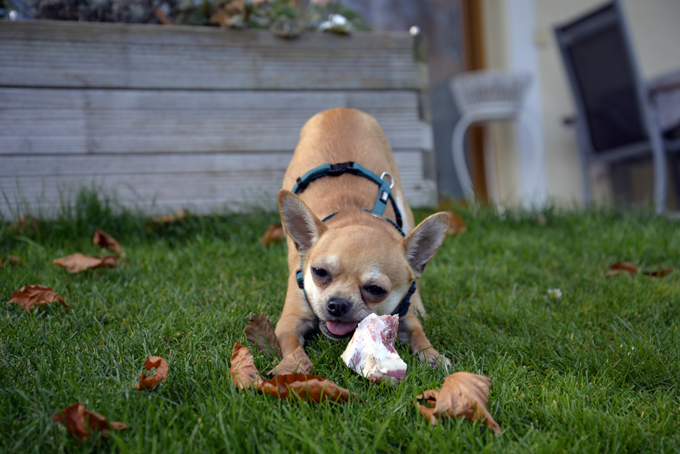
Secondly, avoid feeding bones that are too dense for your pet. For cats, feed light bones (for example, the bones from Cornish game hens, chicken wings, and even rodents like mice and small rabbits). You might have to feed lighter bones (Cornish game hens, for example, instead of chickens) to your cat until they build up their jaw strength. A good rule of thumb for cats is if you can’t cut it with shears, it’s not appropriate for your cat. For dogs, you can feed more dense bones (ribs, poultry frames, and so on), but avoid feeding the weight-bearing bones (leg bones) of large ruminants, such as cows or sheep. That’s because these bones are incredibly dense, and dogs, especially those that are enthusiastic chewers, can crack a tooth on the bones.
Thirdly, it’s important to feed the right size bone to your dog or cat. That means feeding bones that are bigger than their mouths. Feeding this way forces your pet to cut their food into appropriately bite-sized pieces instead of gulping down to big of a piece. This is especially important for canine and feline novice bone chewers, but it’s a good rule to follow even for dogs and cats that have bone-eating experience.
Fourth, make sure you feed raw meaty bones—in other words, bones that have meat still attached to them. This is what our dogs and cats evolved to eat, and feeding this way forces them to rip, shred, and tear the meat off the bone. This in turn slows them down, so they don’t just try to swallow the bone whole. Like our third rule, it’s vital to follow this rule with novice bone eaters, because it teaches them how to eat bones properly. But, it’s a good rule of thumb for more-experienced raw meaty bone eaters as well.
Fifth, keep an eye on your pet when they’re eating, especially when they’re eating raw meaty bones. Even for experienced chewers, this is an important rule to follow (and by the way, this goes for everything, not just bones—meat, organs, even kibble and canned food). If your pet does choke, or has some other kind of problem, you want to be able to help them immediately. I will mention that, particularly if you have a dog or cat that you are transitioning from kibble or canned food over to a raw, fresh, balanced species-appropriate diet, you may see a little bit of blood in their mouths or on their food for a few days at the beginning of the transition. Because the bones act as floss and a good toothbrush, if they have a build-up of tartar and plaque (and most animals on a processed-food diet do), there will be a very small amount of blood until their gums are tougher and healthier and the tartar and plaque are reduced (generally only a few days). It’s nothing to be concerned about, just as you wouldn’t be concerned if you started flossing your teeth after a long period without flossing and saw a small amount of blood. However, if you see a large amount of blood, you need to investigate and help your pet immediately.
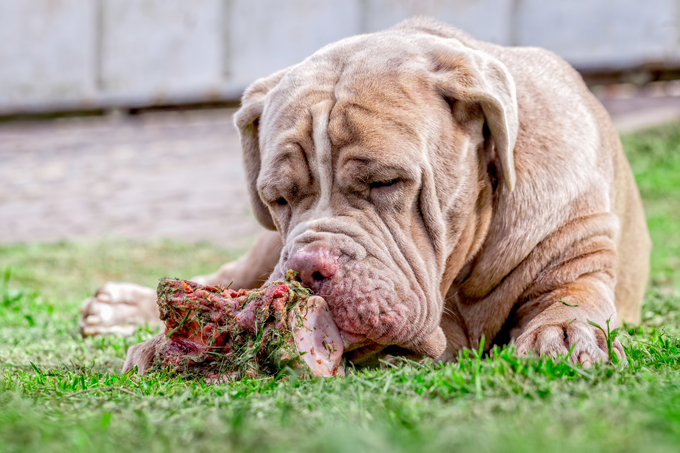
Finally, if you have more than one pet, separate and monitor them when you’re feeding bones (or anything else, for that matter). Following this rule ensures you don’t have any fights because somebody got too close to someone else. Plus, it prevents one pet from gulping down a bone or other food before they’ve had a chance to get it to a bite-sized piece, just to keep someone else from stealing it. Everyone should be able to eat in peace, and you have to monitor them to make sure they can.
If you’ve never fed your pet raw meaty bones before, transition them slowly. You might notice some bone shards in their stool, or they might throw up some bone at first. As they replenish their digestive enzymes and their stomach pH gets where it’s supposed to be, this will go away. You can watch their stool to make sure you’re feeding the right amount of bone: you’re looking for stools that are firm but moist. If they’re loose, you can feed a bit more bone. If they’re super dry and crumbly, feed a bit less.
Whether you have a dog or cat, feeding raw meaty bones regularly (especially if you cut out processed food and feed them a varied species-appropriate raw food diet) can help support good dental health. It can also save you money because you won’t have to get their teeth professionally cleaned. It’s a win-win for both you and your pet, so why not let them try a raw meaty bone today?
-By Kristin Clark, MA, CSAN
Editor-in-Chief, Raw Pet Digest
Founder, Raw Pets Thrive Movement
www.rawpetsthrive.com
www.rawpetdigest.com
www.facebook.com/rawpetdigest
